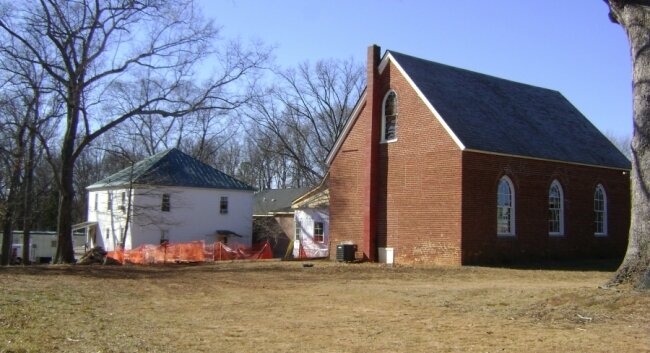Goodbye, old manse: BOS dooms 140-year-old church building
On April 20, the County Board of Supervisors approved the demolition of a 140-year-old church building in Keswick, a decision that would appear to run contrary to one of the goals of the County's Comprehensive Plan, which is to protect historic resources in the rural areas. Indeed, according to County planning staff, the planned demolition was one of the "unfavorable factors" of a plan to build a new facility on the site of historic South Plains Presbyterian Church site, a new structure approved in 2009 and dedicated in June.
What's more, it appears the fate of the doomed building, a circa 1870 "manse," or home for the pastor, was sealed two years ago when the Supervisors approved a plan to build the new church facility in front of it, despite a compromise crafted to retain the original building.
Founded in 1819, South Plains is one of the oldest Presbyterian churches in the County and the "mother" church of Charlottesville's First Presbyterian. Originally a simple, one-room, bathroom-less brick structure, it was later altered to incorporate Gothic Revival features and a vestibule. Along with the adjacent manse, the property has offered a familiar postcard-like scene at the intersection of Louisa and Black Cat Roads.
The new facility was finally dedicated in June, allowing the congregation, which has been worshiping at the old church continuously for nearly 200 years, to realize a dream they've had for over a decade, and for which they raised $700,000: a 4,500-square-foot, Bill Atwood- (of Waterhouse fame) designed building with a large gathering room, kitchen, classroom, choir room, office space, and bathrooms.
But why, two years later, has the congregation been allowed to demolish the old rectory?
"The proposal retains the rectory [manse], which is positive," wrote Margaret Maliszewski, the County's historic preservation manager, in a March 2009 memo. "However, building the new structures around the rectory [manse], as proposed, ignores its historic significance and discounts its architectural form and character."
Maliszewski and the County's preservation committee, on whose behalf she wrote, were concerned that the new facility would obscure the old church and rectory from view along the road. Indeed, while the old church is still visible, the manse is now hidden behind the new facility. And the demolition plan really rankles some.
"The retention of the manse was a critical part of a compromise among many stakeholders that was ultimately approved by the County Board of Supervisors," neighbor Jonathan Rintels wrote to the Supervisors in January. "Nothing has changed since the granting of that approval that now warrants undoing that carefully crafted compromise."
According to archived Planning Commission minutes, there was some discussion about putting the new building behind the old church and manse, but at the April 20 Supervisors meeting, Atwood said that the scenic location and the mature trees were the primary concerns, and that the manse was a "distant third" on the list.
"The manse is an obstacle to a more pleasant scene and not as relevant as it once was," said Atwood, saying it was "pretty much gone" when the final design scheme was approved.
"It's not worth repairing," local builder Preston Stallings added at the meeting. "Whoever said it was historic doesn't know much about history."
Bill Orr, a congregation member and developer, said the manse wasn't "built of good materials" and had "really deteriorated." He said that estimates to move it ran $30,000 to $40,000 and that historic salvage companies weren't interested beyond a $1,000 bid for the materials.
In January 2011, County planner and historic preservationist Eryn Brennan responded to the congregation's demolition request by saying it contributed to the historic district. However, even while urging its preservation, she noted that the new facility had "diminished" the manse's value as a contributing historic resource.
However, Rintels points out that the view of the manse is still prominent to travelers on Black Cat Road and also to residents to the rear and east of the site, who, if the manse is removed, will be left with a "jarringly head-on view" of "a non-contributing, non-rural, non-historic, non-scenic structure."
There is currently no timetable on when the manse will come down, but as part of the demolition approval, it will be thoroughly documented by County preservation staff. A church leader says the church plans to have it recycled after it's "respectfully dismantled."

5 comments
Just because a building is old doesn't mean it's not ugly. Good riddance.
We are, building by building disappearing our own history, and I find this another sad example.
Here is an excellent resource documenting this trend:
" Lost Communities of Virginia "
http://readthehook.com/90478/found-virginias-lost-communties
"the church plans to have it recycled after it's "respectfully dismantled."
send it to van der Linde "recycling" where they will smash it with a tractor, mix it with everyone else's garbage, "recycle" some, and send it off to Shoosmith and 623 landfill for proper burial.
Yes like other members of The Commonwealth I was saddened to learn that Mr Jefferson's privy had been dismantled and used for kindling. Now this lovely example of 19th Century Jacklegg Style is being tossed aside. Oh I'm going to need a mint julip to drown my sorrows. Oh Vidalia do bring me another please...
The manse is gone.